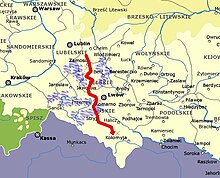Jan Sobieski's expedition against the Tatar chambuls was a successful military campaign that aimed to disperse the Tatars who were pillaging the Polish-Lithuanian Commonwealth during the Polish-Ottoman War (1672-1676).
| John III Sobieski's trip to Tatar forces | |||||||
|---|---|---|---|---|---|---|---|
| Part of Polish–Ottoman War (1672–1676) Crimean-Nogai slave raids in Eastern Europe | |||||||
 John III Sobieski's trip to Tatar forces | |||||||
| |||||||
| Belligerents | |||||||
|
|
| ||||||
| Commanders and leaders | |||||||
|
|
| ||||||
| Strength | |||||||
| 2,500–3,000 | 20,000 | ||||||
| Casualties and losses | |||||||
| Unknown | Heavy | ||||||
Background
editAfter capturing Kamieniec Podolski, the Ottoman army began the siege of Lwów on September 20. At that time, the Tatars, who were not taking part in the siege, aided by Hetman Petro Doroshenko's Cossacks and some Ottoman troops divided into three main groups, ravaged the Polish-Lithuanian Commonwealth. Between the Wieprz and San rivers, the forces of Jiambet Giray were active, while the Nurredin-Sultan's forces were active south of the Dniester. A third group commanded by Haci Giray operated on the Vistula and the middle San as far as Jasło. In total, these groups numbered about 20,000[1] soldiers and operated in dispersion.
Expedition
editGrand Hetman of the Crown John III Sobieski, who had only 2.5-3 thousand cavalry and dragoons, moved on October 5 from Krasnystaw against the Tatars, without wagons and taking two horses per soldier. Going to the rear of the Tatar groups, he advanced toward Zamość and at night smashed a small chambul in the battle of Krasnobród, and on October 6 two chambuls in the battle of Narol, Poland. On October 7, in the battle of Nemirów, he caught up with and smashed Jiambet's forces.
After a one-day rest on October 8, Sobieski on October 9 caught up with and beat Nurredin-Sultan's main forces in the battle of Komarno, pursuing them to Vyshnia. On October 11, Sobieski's troops crossed the Dniester and set off in pursuit of the retreating Haci Girey. After a strenuous day and night march, the crown army, in the strength of a thousand soldiers (the rest could not keep up and stayed behind), caught up with the Tatars at dawn on October 14 and smashed them in battles at Petranka and Kalush.
Aftermath
editJohn Sobieski, at the head of the cavalry and dragoons, traveled from Krasnystaw to the south in 9 days about 450 kilometers. Acting with great self-sacrifice, the Polish soldiers freed about 44,000[2] people from the Tatar yasir. The Great Hetman of the Crown, who was directing the operations, used a very effective method of throwing a group of several hundred horsemen against the Tatars, which distracted them from the main forces coming from the opposite direction. This method always made it possible to smash the Tatars, and prevented them from encircling the army completely. The extraordinary success of the expedition with such a small force was due to the fact that Sobieski was always able to choose the right direction of action, thanks to which the rapidly advancing Polish troops using the Tatar marching technique were able to catch up with and smash individual enemy cavalries.
See also
editReferences
edit- ^ "Szlak wyprawy hetmana Jana Sobieskiego na czambuły tatarskie w 1672 r." www.sobieski.lubaczow.com.pl. Retrieved 2024-01-10.
- ^ "Wyprawa na czambuły | CKZiU Mrągowo". ckziumragowo.pl. Retrieved 2024-01-10.
Further reading
edit- Urbanowicz, Józef (1971). Mała Encyklopedia Wojskowa. Vol. 3, R-Ż (1 ed.). Warszawa: Wydawnictwo Ministerstwa Obrony Narodowej. p. 169-170. OCLC 830232381.